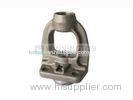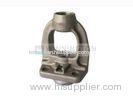Carbon Steel Ceramic Shell Investment Casting For Valve , Lost Wax Casting
Quick Detail:
1. Bonnet of a valve by ceramic shell Casting process;
2. Material: 1.0619 carbon steel;
3. Size: 140X140X350mm;
4. Weight: 11kg;
5. Wax type: medium temperature wax;
6. PED and ISO9001:2008 certificated;
7. NDT can be offered.
Description:
1.0619(Carbon steel) investment castings for valve components, Max size 500X500X350mm;
We cast a wide array of materials: stainless steel, carbon steel, duplex alloys, nickel-based materials, and more with different sizes and configurations:
|
Stainless Steel (70% of our business)
|
Carbon Steel
|
Alloy Steel
|
|
CD4MCu, CD4MCuN, CF3M (AISI 316L), CF8M (AISI 316), CF8 (AISI 304),ANC20,1.4408,1.4517, 1.4306, 303, 430, 420, 17-4PH, SCS1
and more
|
SCS16, SCS14, SCS13, 1.0619, WCB, WCC,S355JR, 1020, 1045 , LCC
and more
|
CLA12C, ANC2,42CrMo,7Q,8Q,4140,6150
and more
|
Overview of Investment Casting Process:
1. Mold making. A wax mould is made according to the CAD system.
2. Wax Model-making. Molten wax is poured into the mould and formed a model that exactly same shape as the cast part.
3. Wax assembly. The wax patterns are connected to the runner system by hot knife according to certain rules. When this finish, a pattern tree is ready.
4. Slurry. The wax pattern tree is dipped into a slurry of silica, then into a sand-like stucco, or dry crystalline silica of a controlled grain size. The slurry and grit combination is called ceramic shell mould material, although it is not literally made of ceramic. This shell is allowed to dry, and the process is repeated until at least a half-inch coating covers the entire piece. The bigger the piece, the thicker the shell needs to be.
5. Burnout. The ceramic shell-coated piece is placed cup-down in an autoclave, who hardens the silica coatings into a shell, and the wax melts and runs out. This process makes hollow in the shell where formerly occupied by the wax.
6. Pouring. The shell is preheated in the clave to harden the patches and remove all traces of moisture, then placed cup-upwards onto a sand bed. Metal is melted in a furnace, then poured carefully into the shell. The shell has to be hot because otherwise the temperature difference would shatter it. The filled shells are then allowed to cool.
7. Release. The shell is hammered or sand-blasted away, releasing the rough casting. The gates, which are also created in metal, are cut off.
8. Machining and finishing. The casting is shot blasted and then machined to required tolerance if necessary. Further finish like plating or polishing can also be operated according to customer needs.
Applications:
flow control (Pumps & Valves, Pipe Fittings)
Machinery
Power & Energy
Automotive
Medical
Military
Marine and Oil
Mechanical Castings









